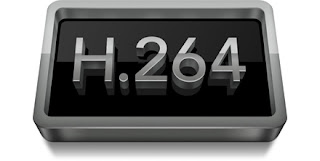At PPD we edit and finish with either Avid or Final Cut. Whatever gets the job done.
Final Cut Pro VS Avid.
S3D - Stereoscopic 3D Finishing / HD Finishing, Colour Correction & Grading / Creative Editing / Tape Outputs & Digital Delivery / Video Digitizing & Encoding / HD & SD Closed Captioning (CC) and Subtitling / Descriptive Video (DV) / Blu-Ray and DVD Authoring / Media Back-up
Search This Blog
Tuesday, 7 June 2011
Tech Talk: MPEG-4 and H.264 - Keeping It Simple
Chances are you've heard the terms 'MPEG-4' and 'H.264' being used a lot lately. I'm going to attempt to explain in basic terms what these are and how you should be utilizing them for your web-based videos.
MPEG-4 is a container
 A container format allows you to combine different multimedia streams (usually video and audio) into a single file. There are plenty of well-known multimedia containers such as: AVI (.avi), Windows' Advanced Systems Format (.wmv), MPEG (.mpg), Apple's Quicktime (.mov) and even Adobe's Flash Video (.flv).
A container format allows you to combine different multimedia streams (usually video and audio) into a single file. There are plenty of well-known multimedia containers such as: AVI (.avi), Windows' Advanced Systems Format (.wmv), MPEG (.mpg), Apple's Quicktime (.mov) and even Adobe's Flash Video (.flv).
You may think of your videos as 'Windows Media files' or 'Quicktimes' but in reality, '.wmv' and '.mov' are just container formats. Just like a ZIP file can contain any sort of data file within it, video container formats only define how to store things within them, not what kinds of data are stored.
MPEG-4 (.mp4) is a type of container that can hold video compressed with the new H.264 codec.
So what's H.264?
 H.264 is a powerful data compression method that delivers high-quality video at a smaller file size. H.264's compression method allows for flexible control enabling the delivery of high-quality video to a variety of devices ranging from low-powered cell phones to high-powered Blu-ray players. This is why the H.264 standard is quickly superseding some of the more common formats such as DV, the popular standard used by many consumer video cameras, and MPEG-2, the standard for DVD video and broadcast digital cable TV. In a nutshell, H.264 is suited to any platform — handheld to high-def.
H.264 is a powerful data compression method that delivers high-quality video at a smaller file size. H.264's compression method allows for flexible control enabling the delivery of high-quality video to a variety of devices ranging from low-powered cell phones to high-powered Blu-ray players. This is why the H.264 standard is quickly superseding some of the more common formats such as DV, the popular standard used by many consumer video cameras, and MPEG-2, the standard for DVD video and broadcast digital cable TV. In a nutshell, H.264 is suited to any platform — handheld to high-def.
What'll play H.264?
An MP4 file containing H.264 compressed video will play on most any Mac and any Windows PC with Quicktime 7 installed. Microsoft has only now begun to support the standard natively in Windows 7 with it's built-in Windows Media Player, however these files will not play in Windows XP or Vista without additionally installed software (ie. Quicktime 7). Recently surveys have indicated that Quicktime 7 on Windows only has a 57% installed base, so it's not a safe bet that your non-technical clients will be able to view any MP4s at least for now.
Flash for now
 Some good news is that Adobe's Flash Video (.FLV) is another alternative for containing H.264 compressed video. Flash (Player 9 Update 3 or greater) has a 99.6% installed base amongst Internet connected computers. This means if your client has a web browser, then they are very likely to have Flash installed and therefore be able to play your H.264 compressed video. A downside is you'll need to have your Flash Video hosted on a website because the Flash Player only works within the Internet browser (Internet Explorer, Safari, etc.)
Some good news is that Adobe's Flash Video (.FLV) is another alternative for containing H.264 compressed video. Flash (Player 9 Update 3 or greater) has a 99.6% installed base amongst Internet connected computers. This means if your client has a web browser, then they are very likely to have Flash installed and therefore be able to play your H.264 compressed video. A downside is you'll need to have your Flash Video hosted on a website because the Flash Player only works within the Internet browser (Internet Explorer, Safari, etc.)
MPEG-4 is a container
 A container format allows you to combine different multimedia streams (usually video and audio) into a single file. There are plenty of well-known multimedia containers such as: AVI (.avi), Windows' Advanced Systems Format (.wmv), MPEG (.mpg), Apple's Quicktime (.mov) and even Adobe's Flash Video (.flv).
A container format allows you to combine different multimedia streams (usually video and audio) into a single file. There are plenty of well-known multimedia containers such as: AVI (.avi), Windows' Advanced Systems Format (.wmv), MPEG (.mpg), Apple's Quicktime (.mov) and even Adobe's Flash Video (.flv).You may think of your videos as 'Windows Media files' or 'Quicktimes' but in reality, '.wmv' and '.mov' are just container formats. Just like a ZIP file can contain any sort of data file within it, video container formats only define how to store things within them, not what kinds of data are stored.
MPEG-4 (.mp4) is a type of container that can hold video compressed with the new H.264 codec.
So what's H.264?
 H.264 is a powerful data compression method that delivers high-quality video at a smaller file size. H.264's compression method allows for flexible control enabling the delivery of high-quality video to a variety of devices ranging from low-powered cell phones to high-powered Blu-ray players. This is why the H.264 standard is quickly superseding some of the more common formats such as DV, the popular standard used by many consumer video cameras, and MPEG-2, the standard for DVD video and broadcast digital cable TV. In a nutshell, H.264 is suited to any platform — handheld to high-def.
H.264 is a powerful data compression method that delivers high-quality video at a smaller file size. H.264's compression method allows for flexible control enabling the delivery of high-quality video to a variety of devices ranging from low-powered cell phones to high-powered Blu-ray players. This is why the H.264 standard is quickly superseding some of the more common formats such as DV, the popular standard used by many consumer video cameras, and MPEG-2, the standard for DVD video and broadcast digital cable TV. In a nutshell, H.264 is suited to any platform — handheld to high-def.What'll play H.264?
An MP4 file containing H.264 compressed video will play on most any Mac and any Windows PC with Quicktime 7 installed. Microsoft has only now begun to support the standard natively in Windows 7 with it's built-in Windows Media Player, however these files will not play in Windows XP or Vista without additionally installed software (ie. Quicktime 7). Recently surveys have indicated that Quicktime 7 on Windows only has a 57% installed base, so it's not a safe bet that your non-technical clients will be able to view any MP4s at least for now.
Flash for now
 Some good news is that Adobe's Flash Video (.FLV) is another alternative for containing H.264 compressed video. Flash (Player 9 Update 3 or greater) has a 99.6% installed base amongst Internet connected computers. This means if your client has a web browser, then they are very likely to have Flash installed and therefore be able to play your H.264 compressed video. A downside is you'll need to have your Flash Video hosted on a website because the Flash Player only works within the Internet browser (Internet Explorer, Safari, etc.)
Some good news is that Adobe's Flash Video (.FLV) is another alternative for containing H.264 compressed video. Flash (Player 9 Update 3 or greater) has a 99.6% installed base amongst Internet connected computers. This means if your client has a web browser, then they are very likely to have Flash installed and therefore be able to play your H.264 compressed video. A downside is you'll need to have your Flash Video hosted on a website because the Flash Player only works within the Internet browser (Internet Explorer, Safari, etc.)Conclusion
If you want a great looking video on the web, encode the file to Flash (.FLV) using the H.264 codec.
Useful Tip: The WDTV Media Player - Easy HD Without The Disc
 |
| WD TV Live |
This device will be great for anyone doing boardroom presentations, trade shows or even digital signage. Call us for details on how we can edit and encode videos for use on the WD TV media player or for a demo.
Links:
Western Digital's 'WD TV Live'
WD TV Live at Best Buy



Links:
Western Digital's 'WD TV Live'
WD TV Live at Best Buy


Subscribe to:
Comments (Atom)
